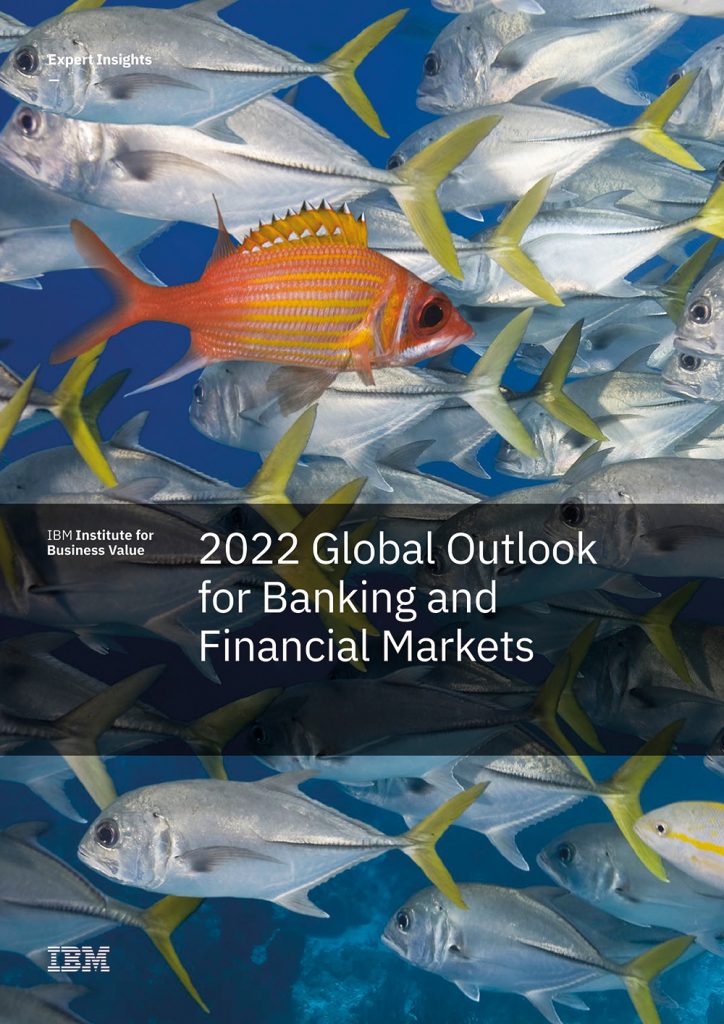Paolo Sironi, IBM: 2022 Global Outlook for Banking and Financial Markets
 In the third year of a global pandemic, the financial services industry appears to be acclimating to a new reality. Many temporary measures put in place are now poised to become permanent, and a new industry structure is emerging. While the industry may have averted a major crisis, it is still underperforming its pre-financial crisis levels. It has lagged many other industries — and a host of new competitors — in several dimensions, including financial performance, customer experience, and embracing new business, operating, and collaboration models. Banks are facing three key transformation needs. First, they must address the end-to-end digitisation of enterprise-wide operations to enable new customer-centric business models, new products and services, new ways of working, and an ecosystem of partners. Digitisation is critical to meeting customer expectations and powering financial performance across revenue, costs, and capital. Second, they must transform the core data environment to drive efficiency and flexibility. They must leverage the collaborative use of deep analytics and AI at scale. This includes building an ethical framework around how data is captured, stored, and used. Third, they must enable a modern and flexible technology architecture to deliver optimal interoperability and portability to support the deployment and management of workloads across multiple compute environments, while helping financial services organisations meet security and compliance requirements.
In the third year of a global pandemic, the financial services industry appears to be acclimating to a new reality. Many temporary measures put in place are now poised to become permanent, and a new industry structure is emerging. While the industry may have averted a major crisis, it is still underperforming its pre-financial crisis levels. It has lagged many other industries — and a host of new competitors — in several dimensions, including financial performance, customer experience, and embracing new business, operating, and collaboration models. Banks are facing three key transformation needs. First, they must address the end-to-end digitisation of enterprise-wide operations to enable new customer-centric business models, new products and services, new ways of working, and an ecosystem of partners. Digitisation is critical to meeting customer expectations and powering financial performance across revenue, costs, and capital. Second, they must transform the core data environment to drive efficiency and flexibility. They must leverage the collaborative use of deep analytics and AI at scale. This includes building an ethical framework around how data is captured, stored, and used. Third, they must enable a modern and flexible technology architecture to deliver optimal interoperability and portability to support the deployment and management of workloads across multiple compute environments, while helping financial services organisations meet security and compliance requirements.
In this year’s Global Outlook for Banking and Financial Markets, the IBM Institute for Business Value invited the global IBM industry experts to discuss these transformation needs, reflecting on their experience with clients over the last 12 months and their expectations for the coming year. Their collective point-of-view highlights ten top industry imperatives:
– Real industry reinvention. Begin real reinvention — now—to solve the structural weaknesses that constrain financial performance. Financial institutions must seek out new business models to drive incremental revenue gains, new operating models and compute environments that structurally reduce operating costs, and new approaches to improve the efficiency of capital.
– Customer-centric business models. Build new customer-centric platform business models to orchestrate and integrate the many needs of ecosystem participants in a more frictionless environment. Leading financial institutions are creating their own bank-led ecosystem business models to serve attractive market segments, while deeply integrating their products and services with other companies’ well-established platforms.
– End-to-end digitisation. Embrace end-to-end extreme digitisation to reshape operations and drive innovation. To win the race to all things digital, financial institutions are adopting new ways of exploiting exponential technologies such as automation, hybrid cloud, and AI. They drive digitisation across internal business units and their ecosystem of external partners while helping ensure security and compliance.
– Operational resilience. Act with urgency to increase resiliency for better risk management and to address regulatory concerns. As financial institutions pivot workloads and volumes to new channels, operations, and partners in response to the pandemic, resiliency has leapt to the forefront of industry priorities. Further resiliency improvements are required to support new business and operating models now being embraced by the industry.
– Viable sustainability. Find viable sustainability models so financial institutions can launch initiatives to meet market expectations, regulatory requirements, and corporate ethical objectives — all with an acceptable cost-benefit case.
– Transformed use of data and AI. Deploy AI factories and transformed data environments that put data in action to accelerate transformation. By ethically adopting new deep analytics and AI tools, financial institutions can enhance operations and customer experiences, and better meet regulatory obligations.
– New workforce and new workplaces. Embrace the reality of a new workforce in new workplaces that redefine how, where, and when work is performed. The financial institution’s workforce now incorporates employees, subcontractors, vendors, and partner employees. New models can enable effective collaboration across this expanded workforce in changing physical and digital work environments.
– New ecosystem architectures. Engage an ecosystem of partners to fuel faster innovation and efficiency. As financial institutions accelerate their transformation, they increasingly partner externally to deliver better functionality at a structurally lower cost across their operating model.
– Emerging digital assets. Tap into the growing momentum for digital assets by working to create new customer and partner ecosystems, new products and services, and new use cases. Financial institutions can be enablers and product providers in the fast-growing digital asset marketplace.
– Security and fraud. Stay one step ahead in the new frontiers of cybersecurity as bad actors become increasingly sophisticated. While new business and operating models are providing innovative ways to serve customers anywhere and anytime, they also create opportunities for security breaches. Financial institutions are revisiting their enterprise risk profile and deploying enhanced security capabilities within their walls and across their ecosystems.
Many organisations have already started addressing some or most of these compelling needs. Others are not keeping pace. A new model for consuming financial services and accelerated digitisation across the industry demands that institutions adjust course and begin real transformation today.
The 2022 Global Outlook for Banking and Financial Markets can be downloaded in full found on IBM, the Institute for Business Value pages: ibm.co/2022-banking-financial-markets-outlook
About the Author

Author: Paolo Sironi
Paolo Sironi is the global research leader in banking and financial markets at IBM Consulting, the Institute for Business Value. He is one of the most respected fintech voices worldwide, providing business expertise and strategic thinking to a network of executives among financial institutions, start-ups, and regulators. He is a former quantitative risk manager and start-up entrepreneur. Paolo’s literature explores the biological underpinnings of financial markets, and how technology and business innovation can bolster the global economy’s immune system in today’s volatile times. Visit Paolo’s website thePSironi.com for more information.
You may have an interest in also reading…
Magatte Wade: An African Serial Entrepreneur with a Heart
She’s none too serious, loves joking around and utterly fails to get the point of forced sex. Meet Magatte Wade,
Uncertainty is the Only Certainty for BlackRock Founder Larry Fink — but his Outlook is still Positive
Kind-hearted, controversial, keen on going green: the billionaire Larry Fink champions worthy causes without fear or favour By TONY LENNOX
Christine Riordan: Leading Rapid Change
In today’s accelerated business environment, the ability to anticipate and actively lead change on a daily basis is essential for



















































































